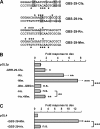Glucocorticoid regulation of mouse and human dual specificity phosphatase 1 (DUSP1) genes: unusual cis-acting elements and unexpected evolutionary divergence
- PMID: 19940143
- PMCID: PMC2807321
- DOI: 10.1074/jbc.M109.037309
Glucocorticoid regulation of mouse and human dual specificity phosphatase 1 (DUSP1) genes: unusual cis-acting elements and unexpected evolutionary divergence
Abstract
Anti-inflammatory effects of glucocorticoids (GCs) are partly mediated by up-regulation of DUSP1 (dual specificity phosphatase 1), which dephosphorylates and inactivates mitogen-activated protein kinases. We identified putative GC-responsive regions containing GC receptor (GR) binding site consensus sequences that are well conserved between human and mouse DUSP1 loci in position, orientation, and sequence (at least 11 of 15 positions identical) and lie within regions of extended sequence conservation (minimum 65% identity over at least 100 bp). These were located approximately 29, 28, 24, 4.6, and 1.3 kb upstream of the DUSP1 transcription start site. The homology-based approach successfully identified four cis-acting regions that mediated transcriptional responses to dexamethasone. However, there was surprising interspecies divergence in site usage. This could not be explained by variations of the GR binding sites themselves. Instead, variations in flanking sequences appear to have driven the evolutionary divergence in mechanisms of regulation of mouse and human DUSP1 genes. There was a good correlation between the ability of cis-acting elements to respond to GC in transiently transfected reporter constructs and their ability to recruit GR in the context of intact chromatin. We propose that divergence of gene regulation has involved the loss or gain of binding sites for accessory transcription factors that assist in GR recruitment. Finally, a novel GC-responsive region of the human DUSP1 gene contains a highly unusual element, in which three closely spaced GR half-sites are required for potent transcriptional activation by GC.
Figures










Similar articles
-
Transcriptional regulation of human dual specificity protein phosphatase 1 (DUSP1) gene by glucocorticoids.PLoS One. 2010 Oct 29;5(10):e13754. doi: 10.1371/journal.pone.0013754. PLoS One. 2010. PMID: 21060794 Free PMC article.
-
Stimulation of MAPK-phosphatase 1 gene expression by glucocorticoids occurs through a tethering mechanism involving C/EBP.J Mol Endocrinol. 2008 Oct;41(4):239-49. doi: 10.1677/JME-08-0015. Epub 2008 Aug 5. J Mol Endocrinol. 2008. PMID: 18682532
-
Anti-inflammatory effects of selective glucocorticoid receptor modulators are partially dependent on up-regulation of dual specificity phosphatase 1.Br J Pharmacol. 2012 Feb;165(4b):1124-36. doi: 10.1111/j.1476-5381.2011.01574.x. Br J Pharmacol. 2012. PMID: 21718312 Free PMC article.
-
How glucocorticoid receptors modulate the activity of other transcription factors: a scope beyond tethering.Mol Cell Endocrinol. 2013 Nov 5;380(1-2):41-54. doi: 10.1016/j.mce.2012.12.014. Epub 2012 Dec 23. Mol Cell Endocrinol. 2013. PMID: 23267834 Review.
-
New insights into the anti-inflammatory mechanisms of glucocorticoids: an emerging role for glucocorticoid-receptor-mediated transactivation.Endocrinology. 2013 Mar;154(3):993-1007. doi: 10.1210/en.2012-2045. Epub 2013 Feb 5. Endocrinology. 2013. PMID: 23384835 Review.
Cited by
-
Glucocorticoid receptors: finding the middle ground.J Clin Invest. 2017 Apr 3;127(4):1136-1145. doi: 10.1172/JCI88886. Epub 2017 Mar 20. J Clin Invest. 2017. PMID: 28319043 Free PMC article. Review.
-
Methylation at the CpG island shore region upregulates Nr3c1 promoter activity after early-life stress.Epigenetics. 2015;10(3):247-57. doi: 10.1080/15592294.2015.1017199. Epigenetics. 2015. PMID: 25793778 Free PMC article.
-
Corticosteroid-induced gene expression in allergen-challenged asthmatic subjects taking inhaled budesonide.Br J Pharmacol. 2012 Mar;165(6):1737-1747. doi: 10.1111/j.1476-5381.2011.01620.x. Br J Pharmacol. 2012. PMID: 21827450 Free PMC article. Clinical Trial.
-
Glucocorticoid Receptor and Adipocyte Biology.Nucl Receptor Res. 2018;5:101373. doi: 10.32527/2018/101373. Nucl Receptor Res. 2018. PMID: 30310815 Free PMC article.
-
Identification of NURR1 as a mediator of MIF signaling during chronic arthritis: effects on glucocorticoid-induced MKP1.Am J Pathol. 2010 Nov;177(5):2366-78. doi: 10.2353/ajpath.2010.091204. Epub 2010 Sep 9. Am J Pathol. 2010. PMID: 20829434 Free PMC article.
References
Publication types
MeSH terms
Substances
Grants and funding
LinkOut - more resources
Full Text Sources
Other Literature Sources
Medical
Miscellaneous

